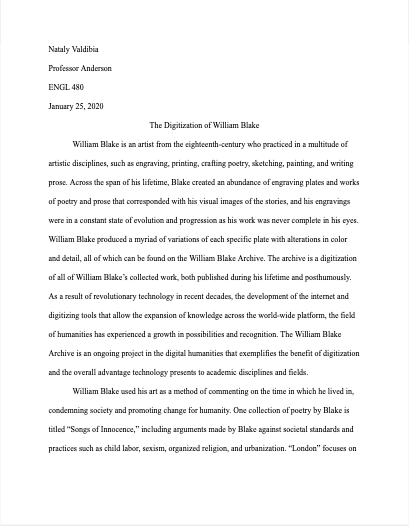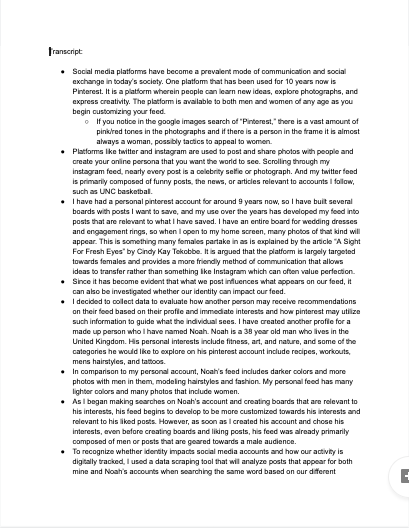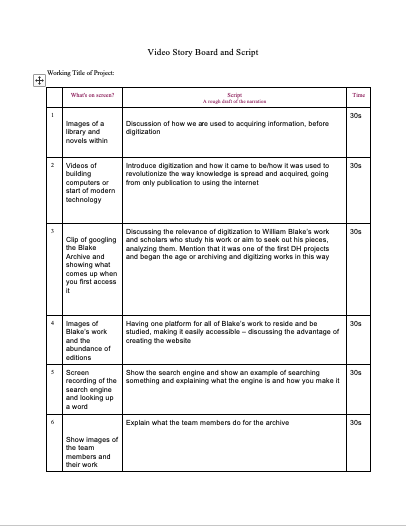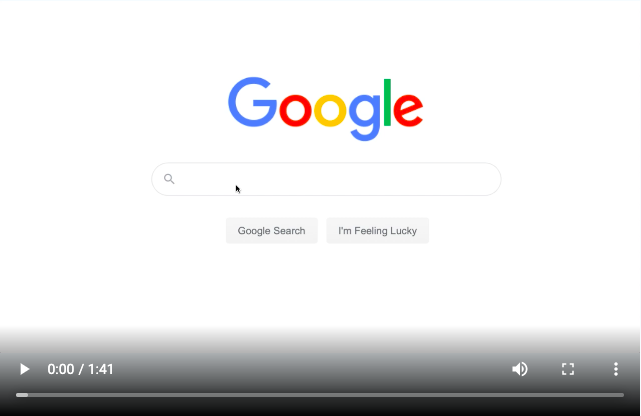INTRODUCTION
Before enrolling this class, and even as I enrolled in the class, I don’t think I had ever even really heard the term “digital humanities.” I was a bit hesitant to enroll in the class due to the digital aspect of the class and the broad description of what the class would entail. As an English major, I am obviously interested in the humanities. However, as someone who is fairly technologically incompetent, I had never really considered the role of technology in the humanities, especially the fact that constantly advancing technology can provide the potential for greater development in other fields. In this class, I was able to explore the broadness of the digital humanities and the capacity for integration between fields and the expansion of knowledge on behalf of digitization. I also learned to expand my knowledge of various technological tools that can be used to make projects in the humanities, which has aided with my comfort and confidence levels regarding technology use. The course educated me about the platforms in which the humanities can be used and expanded upon in regard to educational opportunities and growth. I was particularly interested in our discussion of access and disability, in addition to collaboration and social exchange. Throughout the course, I encountered difficulties with motivation and confidence, but problem-solving and communication were key factors in the ability to analyze, and produce my own, digital humanity projects that benefited from curiosity.
DH PROJECT REPORT
_____________________________________
As we first began exploring the field of digital humanities, we were given the freedom to find some type of existing project in the digital humanities and create a report based on our research of the project. Small groups were formed to create teams of peers who can provide assistance in our navigation of research collection and feedback for reports. The groups were extremely beneficial insofar as that we were provided with individuals who could supply an outside perspective, communicate their own ideas, and aid in my personal comprehension of collaborative groups and their function in the DH field.
Draft:

While trying to decide on a topic to base my report and research on, my lack of knowledge regarding technology and its involvement in the humanities did not help my already lacking motivation to create the report in general as I did not have confidence in my ability to find a topic that would actually interest me or that I would be able to successfully educate myself on. However, my experience in past English courses came in handy as I was able to connect my love for literature and topics I have learned about with the digital aspect of the course. I took an entire course on William Blake, a poet, and artist whose work I grew to deeply appreciate. During the course, I became very familiar with the William Blake Archive, an online digitized archive of every piece of work created by Blake.
Revised Report:

I focused my research on the creation of the archive through online articles and an interview with a member of the team at UNC that contributes to the archive and even leads some aspects of the digital humanities project. I learned that the archive was one of the first digital humanities projects and the first to be academically awarded. Researching the creation of the archive that is dependent on the acquisition of photographs of Blake’s creations and the diligence of dedicated team members was helpful in my understanding of how digitization can benefit the humanities. Through the implementation of a digital archive, the analysis of Blake’s work is available to people all around the world despite their distance from the physical piece that was once necessary to learn about Blake. The archive could be considered a method of social exchange as it allows the spread of ideas and information through an easily navigated project that includes an abundance of sources that can be found and evaluated with a search engine. With the feedback from Professor Anderson, I was able to correct grammatical errors and edit the sentence structure throughout the report to improve the readability and flow of the essay.
DH Video
___________________
We were tasked with the objective of turning our digital humanities reports into a more creative and entertaining format, a video. I decided to take an instructional approach upon creating my video and compiling clips to connect and tell the story of my paper. I planned to screen record as I navigated the archive and displayed its various features such as side-by-side comparison of similar engraving plates to analyze the progression of Blake’s work. The project took the information used in our reports and conveyed it in a different format. Each project had the potential to tell a completely different story in various presentations. I was pleased with the educational aspect of my video project and utilization of clips from videos of Blake’s work and engraving techniques that showed the benefits of the digital archive and ability to scrutinize artwork.
Transcript:
My curiosity about the creation of a search engine prompted my research about how the team members working on the Blake archive collaborate on the vast project. My video shows the result of using the search engine and exhibits the information learned in my report about tagging and coding that is necessary from humans rather than a computer as the technology is not advanced enough to properly recognize all the components of a digital photo and correctly tag them all to be shown in a search engine. My screen recordings display my use of the search engine and all the details involved in a search that also displays the many assignments of team members as they delegate tasks like coding photos and organizing tags to create the most accurate and efficient search engine. I narrated my investigation into the search engine that took information from my report to accommodate the video format of my research. The instructional video about the digital archive of Blake’s work was created from my report, supported by visual navigation of research and narration with instructions and facts.
Storyboard:

Creating a storyboard was a completely new experience to me, prompting my confidence and motivation to slightly diminish after creating a report that utilized my writing abilities rather than creativity. I have created very few video projects in my academic career, and planning out the structure of the video proved to be both beneficial and a bit useless for me. A storyboard is essentially an outline of a video that creates a structure and flow within the visual presentation and designates times to discuss certain aspects of the research. I was able to organize my thoughts and craft an outline that incorporated the highlights of my report research that could be visually modeled. However, I am very disorganized while I create projects as my ideas are sporadic and I come up with ideas and organize my thoughts as I work, moreover, I don’t really stick to timelines or outlines that attempt to organize my ideas prior to actually creating the video and realizing what works well and what should be cut out or shortened. In comparison to my storyboard, the video does not align very well, especially in regard to the time I spend discussing each component of the video. Creating an outline was helpful in at least compiling my thoughts and the best information for my video project, but the structure of the storyboard is not consistent with the final product aside from the information included.
Podcast: Accessibility and Digital Divides
_____________________________________________
Podcast and Podcast Revision
Prior to this course, I had not put much thought into the worldwide impact of technology and its use in academic fields like the humanities. Although there are constant advances in technology, this development does not extend to everyone and every place in the world. Moreover, some regions and populations may be considered to be left in the dark as progress may be restricted due to lacking internet support and resources for technology access. Socioeconomic status is an implication that impacts access to technology and therefore information. Disabilities are another important factor that may limit someone’s access to information and their utilization of digital resources.
Our podcast project entailed the development of a narrative that discussed the implications of limiting factors in regard to technology and its expansion that allows an expansion of knowledge. The small group my peers and I formed to address the topic was useful as we were able to collaborate to understand the subject and find substantial sources that provided facts to support our explanations of how a lack of resources around the world limits the potential for education and knowledge. It was helpful that my group members and I were actually interested in the topic and how a disparity in social and economic circumstances can restrict development. We took turns bringing up and explaining our sources and points of view as we have each experienced different social circumstances and witnessed its impact on individuals in school systems for example.
To practice organizing our discussion to limit confusion and build confidence, we had a practice podcast recording where we had a trial run of presenting our information to each other and creating an efficient discussion and exploration of accessibility issues. I struggle with vocalizing my thoughts in a group setting and often get nervous while hearing myself speak and having everyone focus on me. However, the small group setting made it feel as though we were simply having a conversation, which was one of the intentions of the podcast presentation. The trial run was more successful than our in-class recording where everyone was able to watch and listen to us as the confined setting gave us more comfort since we could focus on just speaking and addressing one another’s information rather than how we were presenting ourselves and our information to the class. I enjoyed the fact that we were able to incorporate not only research but personal experiences with digital divides that can appear as a result of socioeconomic status and region limitations. I was able to gain an understanding of how such disparities can influence the spread, or lack thereof, information, which is a large component of the digital humanities as it relies on the implementation of technology. Although I was uncomfortable with the idea of having to create my own ideas to present to my group and classmates and record the presentation, it was actually quite helpful in my understanding of the digital humanities, audio programs that are used to piece together recordings and create a consistent storyline, and strengthening my confidence and motivation to research and form my own thoughts and opinions that can be supported by evidence or personal experience.
Pinterest Video Report
_______________________________
In-class discussions have raised questions about a different aspect of access as it relates to privacy and the extent to which online mediums can access private information or monitor our usage. Digital platforms like Pinterest, a social media format that is perceived to be geared towards a female audience as the majority of its users are females, base the posts they present to an individual on their profile and identity. Activity is tracked to build a feed that is customized to a member. The platform is easy to navigate and available to people of all ages as social media includes various interest groups to connect people. In comparison to other platforms like Instagram or Twitter, Pinterest has realistic ideas like recipes, DIY projects, and outfit ideas to make users believe what they see is achievable. The community and platform itself are welcoming as it revolves around the sharing and integration of ideas and knowledge to spread to others with similar interests. In the video, I utilized my own account and one I created for a made-up male in his late thirties. The video report tracks the data that is presented on both accounts that are reliant upon the identity of the user and their activity history to present relevant posts.
Video:
In the Pinterest Report Video, I recorded myself using my own account that has been monitoring my activity for many years now, creating a feed that is extremely reflective of my personal tastes and interests. Additionally, I showed my creation and navigation through a made-up account for a 38 year old man living in the UK. I showed what my feed looks like as a 19 year old girl who has boards dedicated to home decor, recipes, and weddings; moreover, my feed is composed almost entirely of wedding gowns, healthy new recipes to try, and beautiful homes. After choosing interests that are typically associated more with men, like sports and mens watches and haircuts, Noah's feed presented me with various photos containing much deeper and darker colors and more men photographed in the images, however, some women did still appear. After using Noah's account more and creating boards for him, the feed became increasingly relevant to his interests as more hairstyles and sports photos were shown with minimal posts containing women. I then showed my use of a data scraping tool that collected search results from both accounts when searching the exact same words. The question behind this data collection was whether identity impacts our feed and the way social media is presented to us, as well as testing whether we are really tracked. Noah's photos included various stereotypically male results or presented results that were geared towards a person of older age, such as photos with families and "how-to" posts about homeschooling children, as well as presenting only male pants when searching for the clothing item. My account results seemed to be influenced by my interests, as well as things that could be aimed towards women, like recipes and home decor, as they could be targeting homemakers. The search of the word "pants" showed the fact that identity was definitely influencing the results of the search and data collection as I was only shown female clothing items, which may have come as a result of my profile that indicates I am a female. The data analysis comparing what people are shown supports the idea that social media platforms and online mediums track our activity to present the most desirable image as well as using information to target people based on their identities.
Transcript:

Portfolio Video
____________________________
Introduction:
As my time in English 480 comes to a close, I have compiled my assignments and projects that have all contributed to my understanding of the digital humanities, a field I was completely ignorant to before the course. Every task has built my comprehension of digital humanities and has exemplified the broadness that allows people from computer science or medicine or any kind of stem field to merge with the humanities through digital tools and platforms to create methods to spread knowledge and expand upon ideas. I began the course confused as to what my workload would entail and concerned about my limited experience with online programs and tools. However, discussions based on articles from various points of view in DH created a foundation for my growing understanding and confidence in my work and knowledge. I became more curious and motivated to learn about the field as I study the humanities and became aware that learning about the digital side of humanities could strengthen my skills and provide new opportunities. My portfolio consists of the work I have produced through the course of the class, each piece adding to my comprehension of digital humanities.
Video:
My portfolio video displays my navigation through our class website as I reflect on past assignments. I was able to show programs that I have become familiar with through our creation of video and audio projects. I discussed my favorite projects that I have completed, which include the DH report and the podcast. I enjoyed being able to utilize my prior knowledge about William Blake and my interest in the literature aspect of the humanities to find and create a project that truly interested me, and being able to turn my report into a visual format built my confidence as I became more familiar with programs like Adobe Rush. The podcast project was interesting as it piqued my curiosity about issues faced within the DH field, such as accessibility and disability issues and limitations. Researching problems regarding the ability for people around the world to actually access platforms was beneficial to my continued acquisition of the digital humanities and the problems it entails. We created a script and recorded our conversation discussing the issues and then created our personal versions of the podcast. Although I had trouble learning Audacity and overcoming glitches and technical problems, I was able to learn about Adobe Audition and the multitude of features it contains to fix problems and add elements to audio. I was able to reflect on the projects that I enjoyed the most and had the greatest impact of my experience with the digital humanities that taught me about the range of ideas and formats it encompasses.
Transcript:

Storyboard:

Comments ______________________
Feedback
____________________
Other Assignments
________________________________


Comments